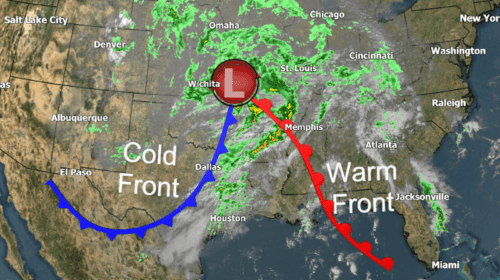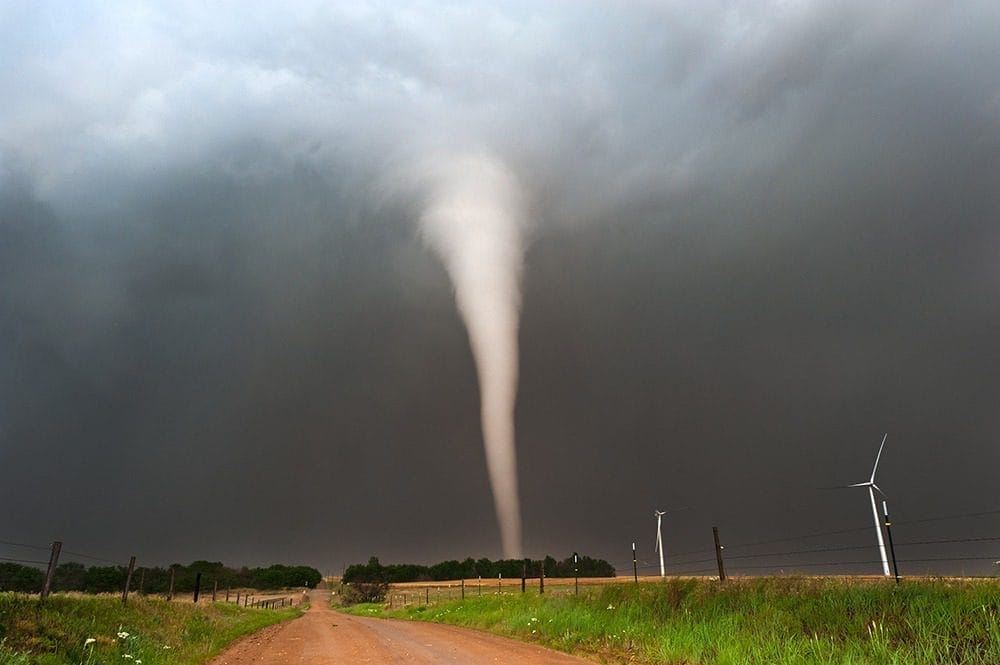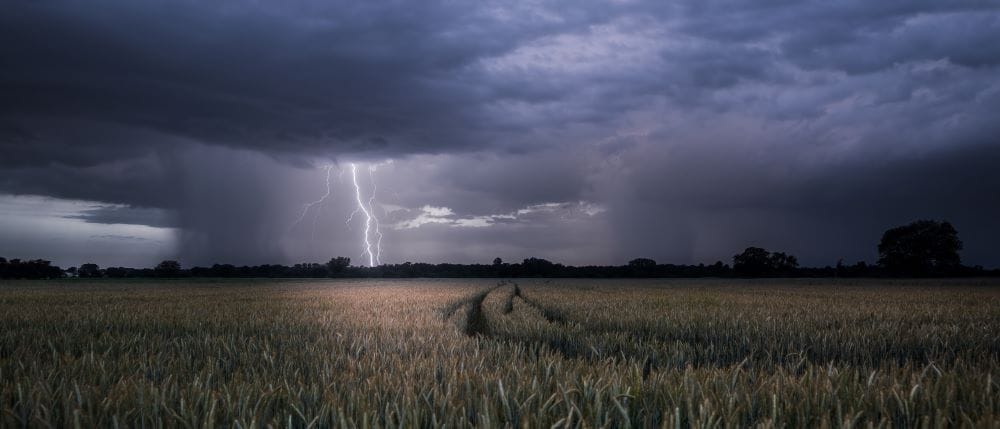The Four Types of Weather Fronts Explained
Weather fronts play a pivotal role in shaping our weather patterns and understanding them is not just the domain of meteorologists. It’s advisable that business leaders and decision-makers in various industries also grasp the significance of weather fronts because they can have a substantial impact on operations, logistics, and planning. Keep reading to explore what a weather front is, why it is essential for non-meteorologists to comprehend them, how meteorologists represent weather fronts using surface weather analysis, the various types of weather fronts, and how our changing atmosphere is impacting the behavior of fronts.
What is a Weather Front?
A weather front is a boundary or transition zone that separates two air masses with different temperature, humidity, and density characteristics. These air masses interact along the front, leading to various weather phenomena. They can bring about significant changes in weather conditions, affecting everything from agriculture and transportation to energy consumption and outdoor events.

Importance of Understanding Weather Fronts for Business Decision-Makers
Knowledge of weather fronts can be valuable for risk management in industries susceptible to weather-related disruptions. For instance, understanding when a cold front will bring severe storms can help businesses prepare for potential power outages or supply chain delays. Energy and resource-intensive industries, such as agriculture, energy production, and manufacturing, rely heavily on weather conditions. Recognizing weather fronts helps in optimizing resource allocation and production scheduling.
Likewise, weather fronts can cause turbulence, fog, and precipitation, which can impact aviation, maritime operations, and ground transportation. Awareness of frontal systems allows for efficient scheduling and contingency planning. Most importantly, business leaders need to understand weather fronts to make informed decisions during extreme weather events to protect employee and customer safety.
Meteorological Representation of Weather Fronts
Surface weather analysis is a critical tool used by meteorologists to represent and visualize fronts on weather maps. It is a sophisticated process that involves collecting, processing, and interpreting a wide range of meteorological data to represent weather fronts accurately. This analysis provides valuable insights into current and future weather conditions, enabling businesses, government agencies, and individuals to make informed decisions and preparations for weather-related events. Understanding the information conveyed by these maps is essential for anyone whose activities are influenced by weather, making it a critical skill for decision-makers in various fields.
Here’s an in-depth look at how meteorologists use surface weather analysis to represent weather fronts:
Data Collection: Meteorologists gather real-time data from multiple sources. This includes information on temperature, humidity, wind direction and speed, atmospheric pressure, and cloud cover. This data comes from radars, ground-based weather stations, ocean buoys, weather balloons, aircraft, and remote-sensing instruments on satellites.
Data Processing: Once the data is collected, it undergoes rigorous processing. This involves quality control measures to ensure accuracy and consistency. Data from different sources and formats are standardized for compatibility.
Frontal Boundaries: To represent weather fronts, meteorologists use specific symbols and lines on weather maps. Here are some common symbols for weather fronts:
- Warm Front (red semicircles): These are half-circle symbols drawn on the side of the front where the warmer air is advancing over cooler air.
- Cold Front (blue triangles): Blue triangle symbols indicate the side of the front where the cold air is advancing and displacing warmer air.
- Stationary Front (alternating red semicircles and blue triangles): When warm and cold air masses are not moving, meteorologists draw a combination of warm front and cold front symbols along the front.
- Occluded Front (purple triangles and semicircles): Purple symbols show that a cold front has overtaken a warm front. These fronts often bring a mix of weather conditions.
Frontal Analysis: Meteorologists analyze the position and orientation of these symbols and lines to determine the type and behavior of the front. They consider factors such as the slope of the front, the movement of the air masses, and the associated weather patterns.
Weather Prediction: By examining the surface weather map with these fronts, meteorologists can make predictions about future weather conditions. For example, the proximity of a cold front to a warm, moist air mass may indicate a high likelihood of thunderstorms or heavy rainfall.
Types of Weather Fronts
Weather fronts are categorized into several types based on their characteristics, movement, and the interactions between air masses. Each type of front brings distinct weather conditions and phenomena. Understanding these different types of weather fronts is essential for predicting and preparing for various weather-related events. Businesses, governments, and individuals rely on this knowledge to make informed decisions, whether it’s for agricultural planning, transportation logistics, or public safety measures. Being able to recognize the signs and effects of different fronts is a valuable skill in managing and mitigating the impacts of weather on daily activities and operations.
Warm Front
Warm fronts occur when a warm air mass advances and replaces a cooler air mass. Warm air rises over the denser cold air, gradually lifting and cooling as it ascends. This process creates a broad, sloping frontal boundary. These fronts typically bring gradual weather changes. As the warm air ascends, it cools and condenses, forming clouds and often leading to precipitation. The precipitation associated with warm fronts is usually gentle, resulting in rain or drizzle. Cloud cover increases as the front approaches. Warm fronts lead to a gradual increase in temperature and humidity as the warm air replaces the cooler air.
Cold Front
Cold fronts form when a cold, dense air mass advances and displaces a warmer air mass. The boundary between the two air masses is typically steeper and more abrupt than with warm fronts. They often bring more dynamic weather changes. As the cold air advances, it forces the warm, moist air to rise rapidly, leading to the development of towering cumulonimbus clouds and the potential for severe weather. Thunderstorms, heavy rainfall, gusty winds, and even tornadoes can occur. Cold fronts result in a sudden drop in temperature as the cold air replaces the warmer air. This temperature change can be quite dramatic, especially along a strong front.
Stationary Front
Stationary fronts occur when two air masses with similar temperature and density characteristics meet but neither advance over the other. As a result, the front remains nearly stationary, with little horizontal movement. These fronts often lead to prolonged periods of cloudy and wet weather. Because neither air mass is actively displacing the other, the convergence of moist air can result in persistent precipitation, such as rain or snow. Weather conditions along stationary fronts are typically less intense than those associated with cold fronts. Temperature changes along stationary fronts are relatively minor, as the front’s position remains stable.
Occluded Front
Occluded fronts occur when a fast-moving cold front catches up with a slow-moving warm front. This results in the cold air overtaking and lifting the warm air off the ground. A mix of weather conditions are often expected from these types of fronts. Precipitation can occur, and the front may produce varying weather conditions, including rain, snow, and temperature fluctuations. Occluded fronts are commonly associated with complex weather patterns. Temperature changes along occluded fronts can vary, but they often lead to more stable and uniform temperatures as the front progresses.
The Impact of Our Changing Atmosphere on Weather Fronts
As our atmosphere holds more moisture, it is having a noticeable impact on the behavior of weather fronts and is contributing to shifts in weather patterns worldwide. These changes are a result of alterations in the Earth’s atmospheric circulation, temperature distribution, and moisture content.
It’s important to note that the impact of our changing atmosphere on weather fronts can vary by region and over time. Local geography, ocean currents, and atmospheric conditions all play a role in determining how weather fronts behave. As a result, understanding and monitoring these changes is crucial for adapting to and mitigating the impacts of climate change on weather-related hazards and disruptions for business organizations.
Here are some ways in which fluctuating atmosphere is influencing the behavior of weather fronts:
Altered Precipitation Patterns
Precipitation patterns are changing, including increased rainfall in some regions and prolonged droughts in others. Weather fronts are responsible for much of this precipitation, and as the climate warms, they can carry more moisture, resulting in more intense rainfall events when they interact with fronts. This can lead to an increased risk of flooding in some areas.
Increased Intensity of Weather Events
Our Changing atmosphere is contributing to the intensification of weather events associated with weather fronts. For example, warm fronts may bring more prolonged periods of heavy rainfall, while cold fronts can lead to more severe thunderstorms and heavy snowfall. This increased intensity can have significant implications for flooding, storm damage, and other weather-related hazards. Unfortunately, more erratic weather patterns are also expected, including an increased frequency of extreme events. This unpredictability can make it challenging for communities and industries to plan and adapt to changing weather conditions.
Changing Frontal Boundaries
The position and behavior of weather fronts are being impacted. Warmer temperatures can lead to shifts in the location of frontal boundaries, altering the timing and frequency of weather events. This can impact agriculture, water resources, and ecosystems that rely on specific climate conditions.
Shifts in Seasonality
Shifts in the timing of seasons and the arrival of weather fronts are occurring. In some regions, this may lead to earlier spring and later fall, affecting growing seasons, wildlife migrations, and other ecological processes that depend on specific temperature and moisture conditions.
Increased Risk of Heatwaves
Our changing atmosphere is leading to prolonged periods of high temperatures. Warm air masses ahead of cold fronts can become even warmer, exacerbating heatwaves when these fronts pass through. This can have severe implications for public health and energy demand.
Impact on Polar Fronts
The polar regions are being affected, including the shrinking of Arctic Sea ice. Changes in polar front dynamics can influence the behavior of mid-latitude weather systems, potentially leading to shifts in storm tracks and weather patterns. The shrinking Artic Sea ice also contributes to rising sea levels. Higher sea levels can lead to increased coastal flooding during storms, particularly when weather fronts interact with cyclones or other low-pressure systems.
Keep Aware of Business-Impacting Weather
Weather fronts are dynamic and influential components of our atmosphere, driving changes in weather patterns that can impact numerous aspects of our daily lives and business operations. For business leaders and decision-makers, a basic understanding of weather fronts is not just beneficial but essential. Being able to interpret surface weather analysis and identify different types of fronts enables proactive planning, risk management, and informed decision-making, ultimately contributing to improved business resilience and success in a developing climate. At Climavision, we have invested in the latest weather technology advancements to provide organizations with the fastest, most accurate insights into weather phenomena such as fronts. If you’d like to learn more about how these weather insights can benefit your organization, contact us.




